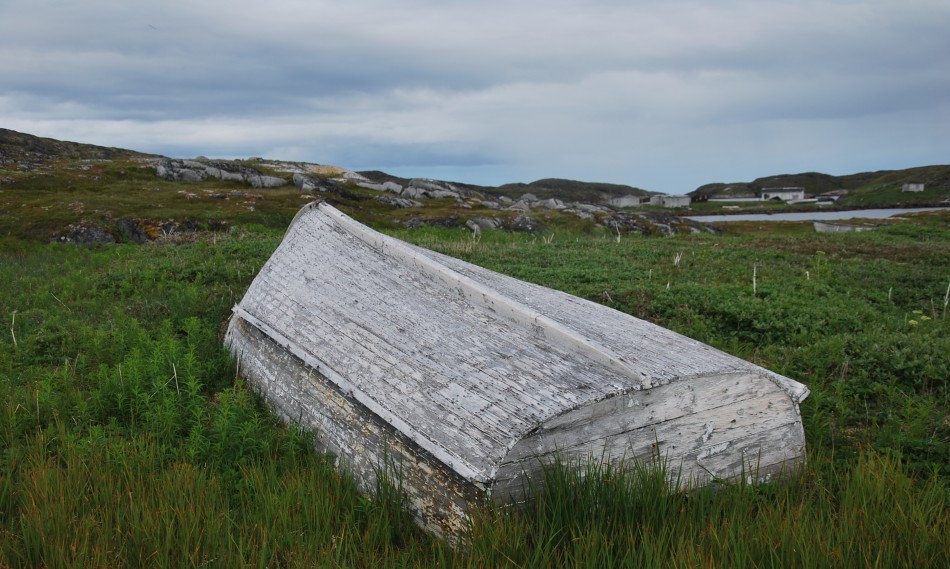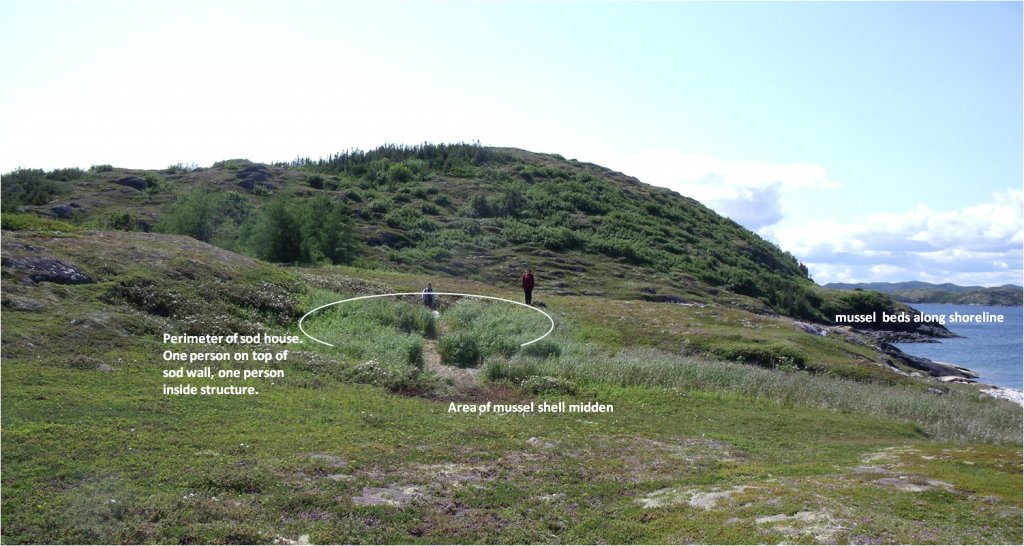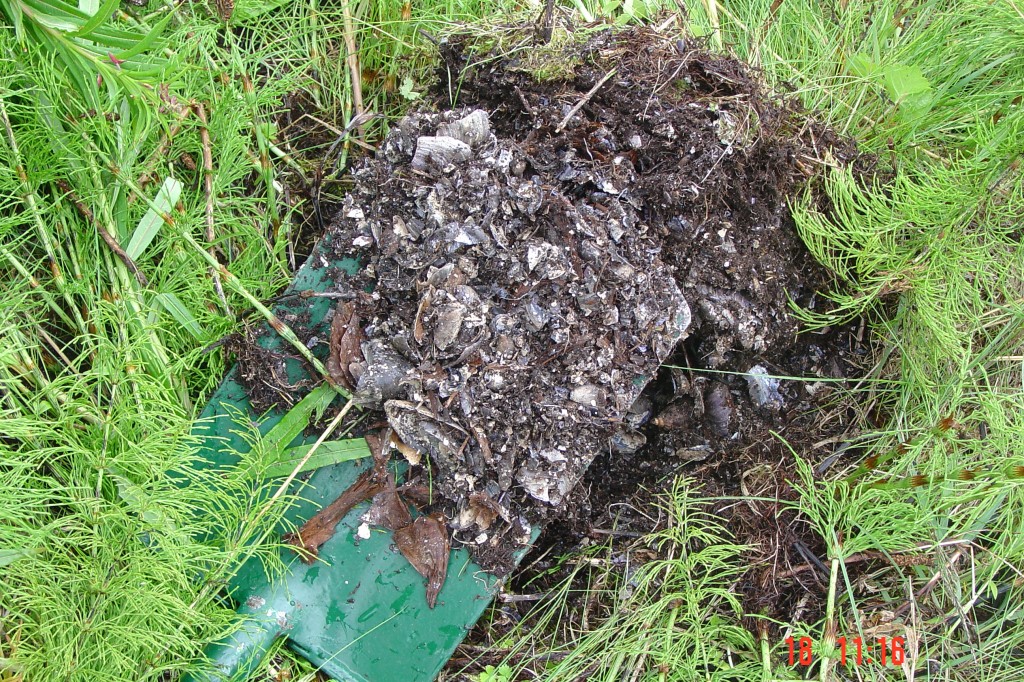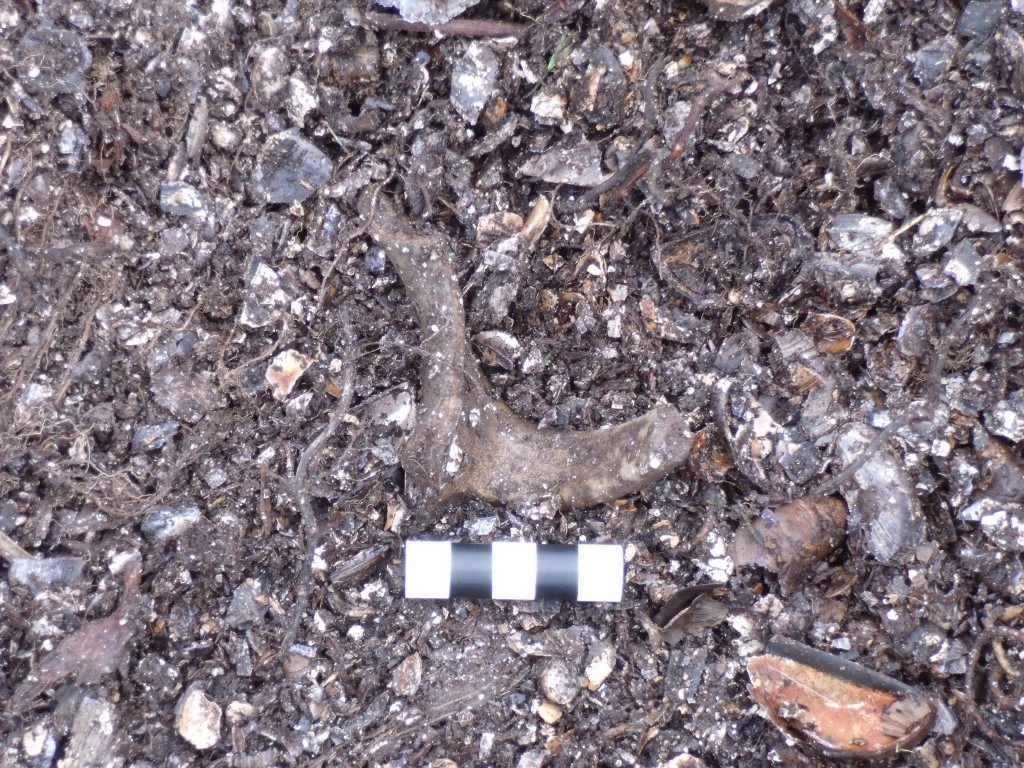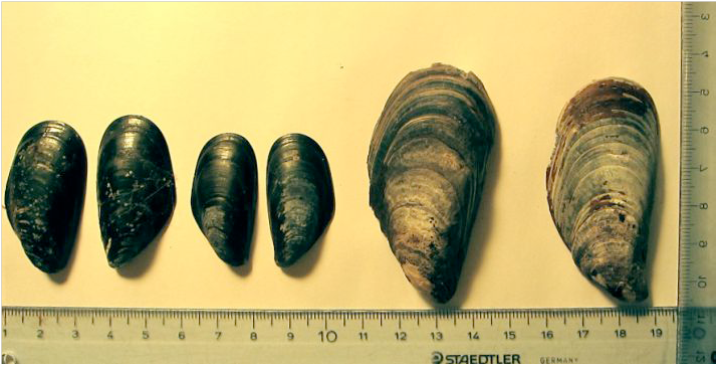![]()
I allocated a portion of project funding to three types of analysis: An analysis of insect remains from soil samples was of interest for what it can reveal about living conditions; Oxygen isotope analysis of blue mussel specimens is a first for Labrador, perhaps for Canada; while the analysis of animal bones was particularly important for what it can tell us about Inuit diet at this site and season of settlement.
![]()
Insect remains from soil samples at FeAx-3 – non-human life inside an Inuit sod house
Two soil samples were collected from the St. Michael’s Bay Inuit site to find out if anything could be learned from the insect remains – a process known as entomological analysis. The samples were sent to Dr. Allison Bain at the Environmental Archaeology Laboratory, Laval University, Quebec City, and Master’s student Frédéric Dussault. Insect remains last centuries in deposits where they once lived and died. They can potentially reveal a great deal about the immediate environment because different species act as proxy evidence for different types of conditions such as wet, dry, leafy, peaty, presence of animals, presence of humans, and so on. The insect remains collected from the soil samples showed exceptional preservation and allowed for unequivocal identification,
The analysis was interesting for both what was present and what wasn’t. Some insects found in the sample (Acidota quadrata, Eucnecrosum tenue, and Euaethetus) occur in damp environments with ground cover such as leaf litter. The sample was collected in the area thought to be the sleeping platform. Like some houses found in northwest Greenland, this sod house does not have a well-defined stone sleeping platform but probably consisted of a mass of vegetation laid atop stones or bedrock. Another insect, Aphodius borealis, is associated with animal dung, which tells us something of conditions within the house. Finally, Dussault and Bain were able to identify species that are not known in the current entomological collections from Labrador, which is either a product of limited sampling from Labrador, or because these species were introduced through European products or people. Absent was any evidence of ectoparasites, or insect types directly associated with humans, such as fleas.
![]()
The mussel shells from FeAx-3 – an oxygen isotope first for Labrador
Most Inuit sod houses in Labrador have garbage deposits outside the entranceway filled with seal bone, broken household items, fish bone, and other throw-aways. These deposits are called middens. The St. Michael’s Bay site has a most unusual midden compared to others I’ve examined in Labrador – it has one of the first mussel shell middens ever found associated with an Inuit dwelling. Broken and some whole specimens of the blue mussel (Mylitus edulis) form a dense, thick matrix that also contains discarded bone tools, European ceramic shards, seal bone, fish bone, and other objects.
Why were mussel shells so abundant at this site? The location may have been chosen by Inuit precisely because of the mussel beds, which would have been a source of food during the leanest time of year, in late winter and early spring, just before bird migrations began and the seal and salmon fisheries.
I was aware of shell midden analyses, or sclerochronology, that had taken place elsewhere in North America and Europe and how important they were for identifying the season(s) that a site was inhabited as well as for evidence of past climates. What I didn’t know, was that clams were mainly used for such analyses over mussel shells, which are much more fragile. In 2009, I approached doctoral candidate Meghan Burchell at McMaster University, who specializes in the analysis of bivalves from archaeological deposits, with my question – could mussel shells provide the same sort of useful data that she was already getting from clam analysis? Over the following two field seasons, samples of live mussel shells were collected from the rich mussel beds along the shoreline next to the site. Much more difficult to both find and extract from the ground were whole mussel shells from the archaeological deposits; these were few and far between, and when found were soft, friable, and prone to instant collapse. Why did they have to be complete? Mussel growth occurs as a series of growth layers, much like tree rings, and the outermost layers are the ones critical for determining season of harvesting. We were fortunate to find several whole specimens and even more fortunate, after painstaking excavation, to get them out of the ground, out of the field, and eventually to a laboratory in Germany where they underwent oxygen isotope analysis.
Burchell worked with Dr. Bernd Schöne at the Institute of Geosciences, University of Mainz, to develop a way of completing effective stable oxygen isotope analyses of the mussel shell samples. The results were encouraging and fit well with what is known about Inuit sod house use, namely that they were cold season dwellings. Of the 13 archaeological specimens analysed, two (2) were identified as collected in winter, four (4) were collected in the autumn, and seven (7) were collected in the spring. There is no evidence of summer collection, which further corresponds with mussel shell growth patterns – mussels along shore during the summer are young ones and tiny while those found on the site were large, mature specimens.
The location of the mussel shell beds and the mussel shell midden in relation to the Inuit sod house.
The first test pit into the mussel shell midden – 2009.
A close-up of the mussel shell matrix. Object in centre is a Normandy stoneware handle and rim. Also visible are fish bones.
Samples of live-collected mussels (4 on left) and mussels from Inuit sod house (2 on right) (photo: M. Burchell).
![]()
The animal bones from FeAx-3 – what the Inuit were eating
Animal bones in the St. Michael’s Bay sod houses were found in nearly every test unit, within the house, outside the house, but mostly in the midden. In addition to blue mussel harvesting, the animal remains, or faunal remains, are of species that the Inuit hunted and fished. All of my faunal analysis was most ably completed by doctoral candidate Lindsay Swinarton, at the Bioarchaeology Laboratory at Laval University, Quebec City.
A total of 18,410 faunal remains were collected from the House A and House B at the St. Michael’s Bay site, most from House B, which was excavated over two and a half field seasons. One of the most distinctive characteristics of this collection of bones is the diversity of species. The Inuit in St. Michael’s Bay ate whatever the surrounding environment offered. In evolutionary terms, tapping into a diversity of species, as these Inuit did, ensures survival and continuity. A number of bones, mainly from inside the house, had cut marks on the surface, made by sharp tools such as knives during butchery. The animal species represented by cut-marked bones were caribou, ringed seal, cod fish, polar bear, fox, dog, harp seal, hooded seal, a gull, a dovekie, and an eider duck. Season of settlement is hinted at by a number of species; ringed seals are a non-migratory species common in winter, while the dovekie (the little auk) spends summers in the Arctic but winters off the coasts of Labrador in winter.
Fish remains made up just over half of the total, identified bones (46%), and these were chiefly of Atlantic cod. Cod is a deep water fish that in pre-European times was not commonly sought by Inuit, who focussed on anadromous species such as char and salmon during their spawning runs into river systems along the coast. The mass of cod bones at FeAx-3 suggests that Inuit here owned European shallops – small, keeled boats with a sail – and used a fish hook technology. The several well-preserved fish hooks found at the site tie in well with the many cod bones.
Mammals of the land and sea were the second most common class of animal bone found at FeAx-3. Of these, the bones of small seal species are the most common, making up 39% of all identified elements. The ringed seal appears to have been the most food source. Whale bone was also found at the site, much of it in the form of artifacts worked by human hands. It could easily have been collected from beached whales and is unlikely to represent a whale hunt. Bones of land-based mammals are much less common, sometimes representing just a single animal, but they do show that all meat sources in the region were exploited. Caribou were caught as was polar bear, arctic and red fox, hare, porcupine, and river otter. Dog bones were also recovered, and many bone fragments from inside House B also bore evidence of dog gnawing. Of the bird remains, the most common were ducks, gulls, dovekies, and grouse.
